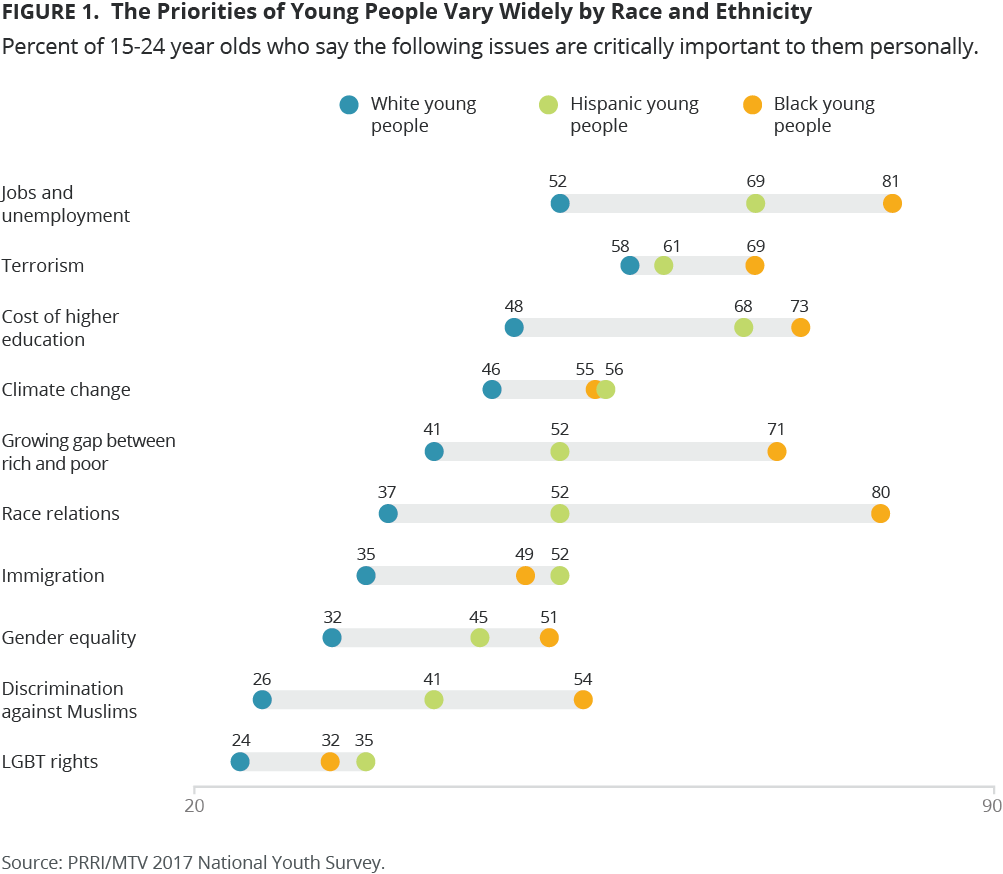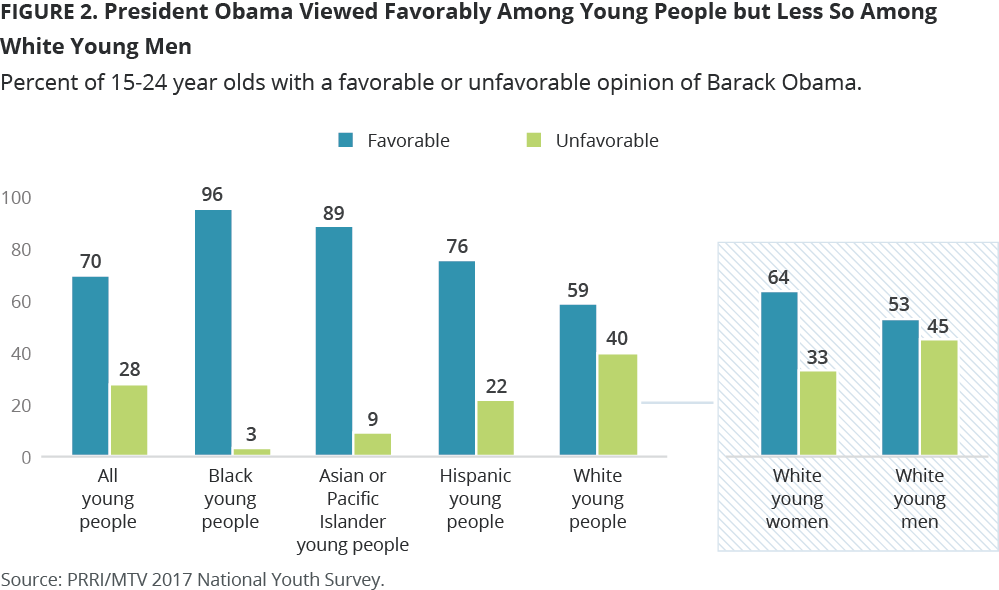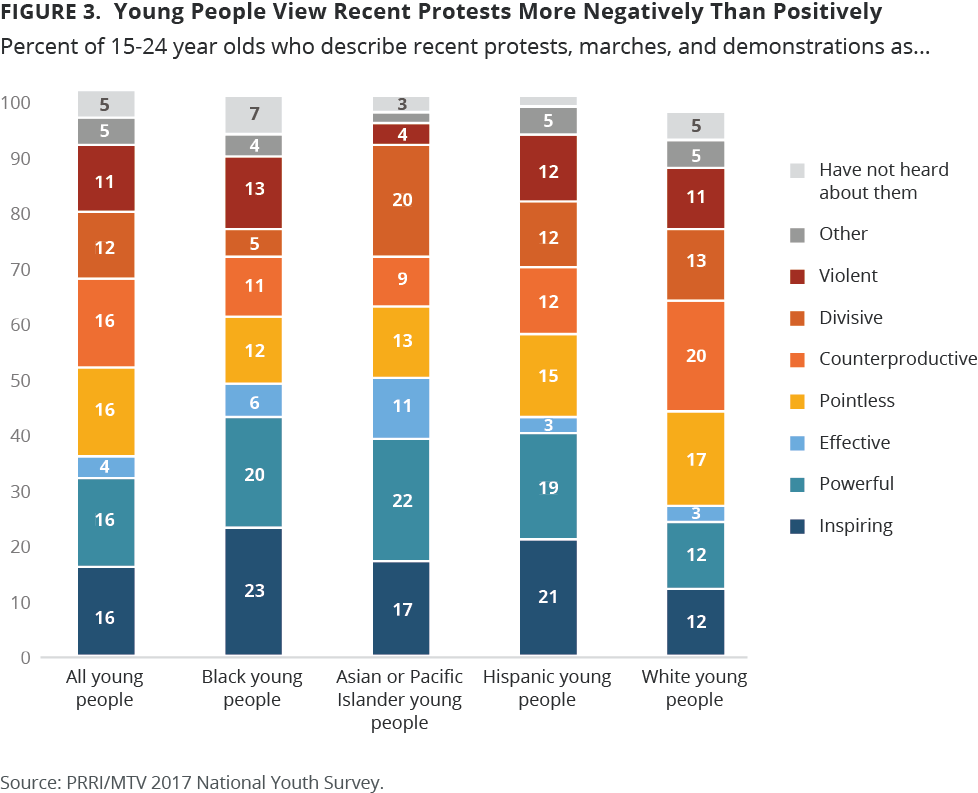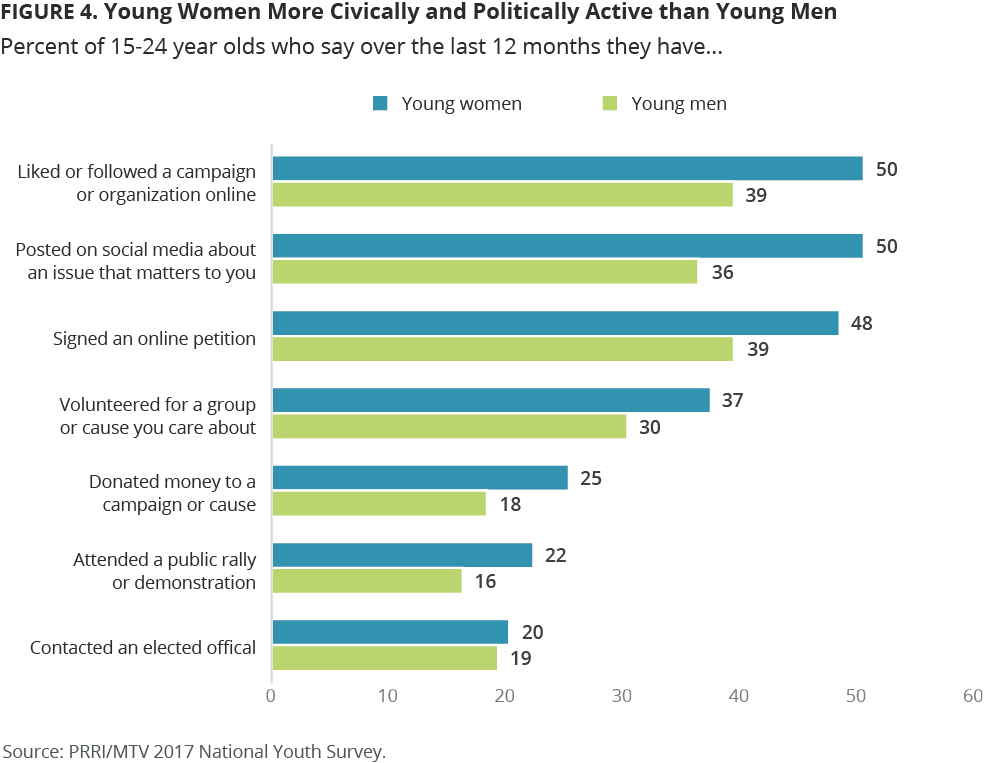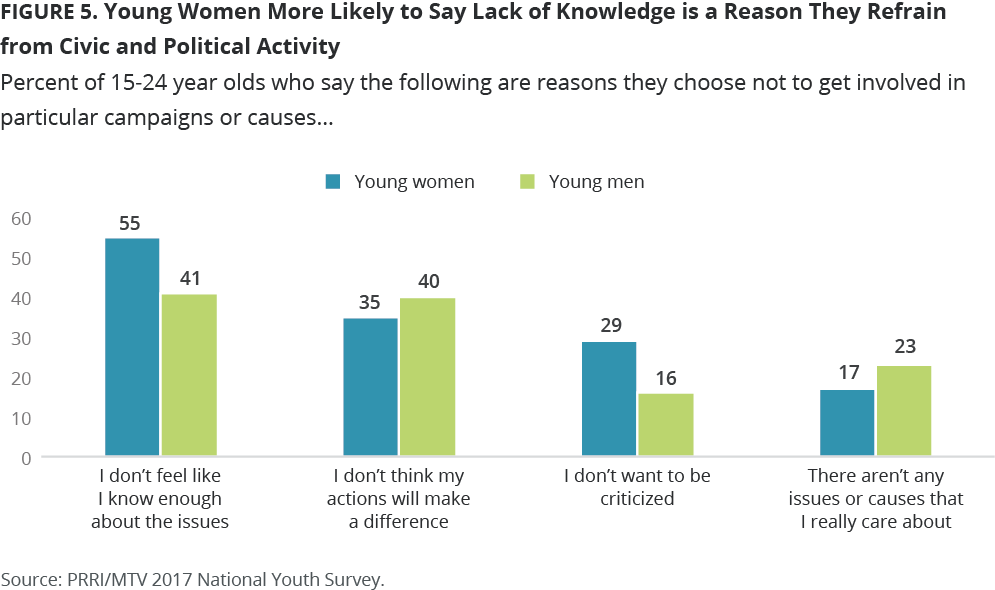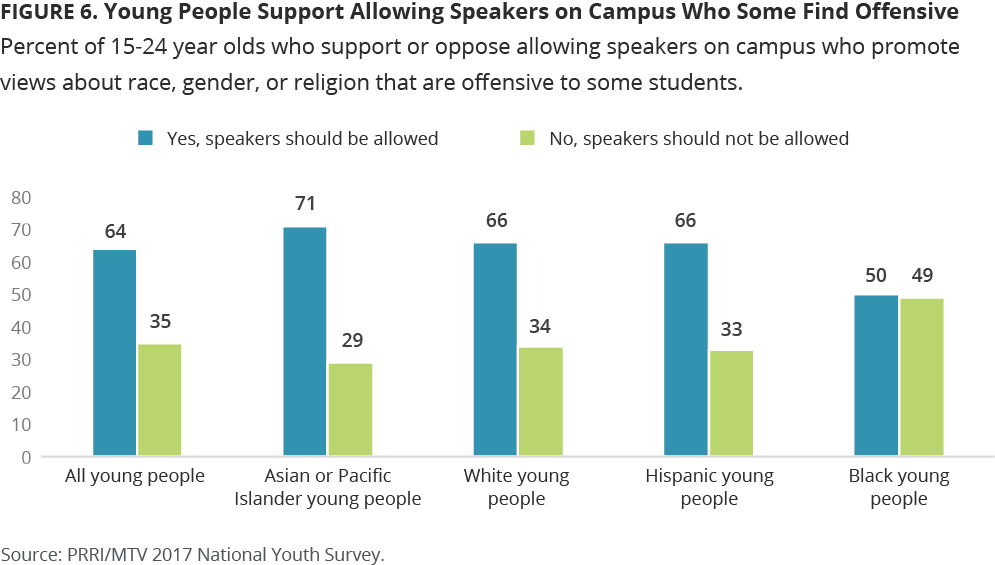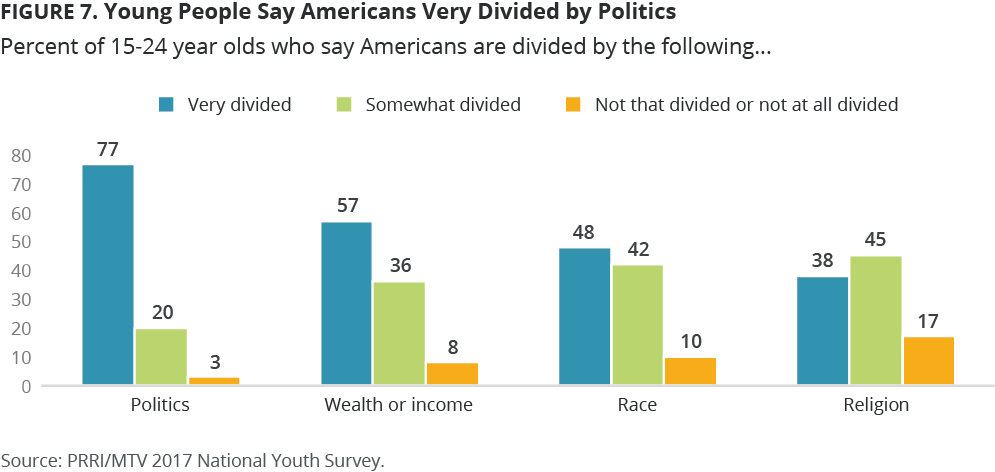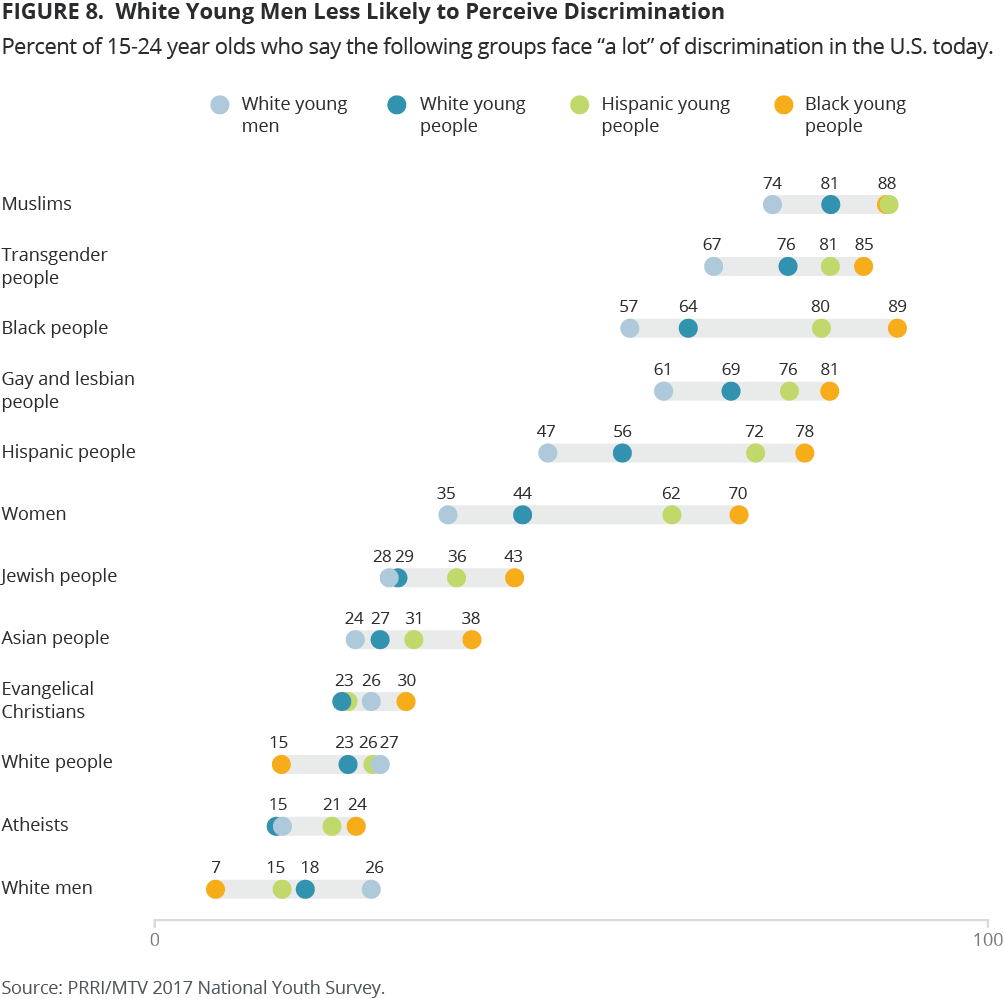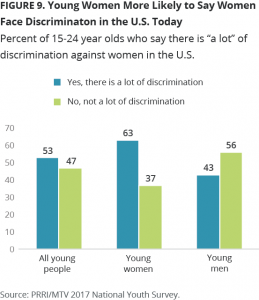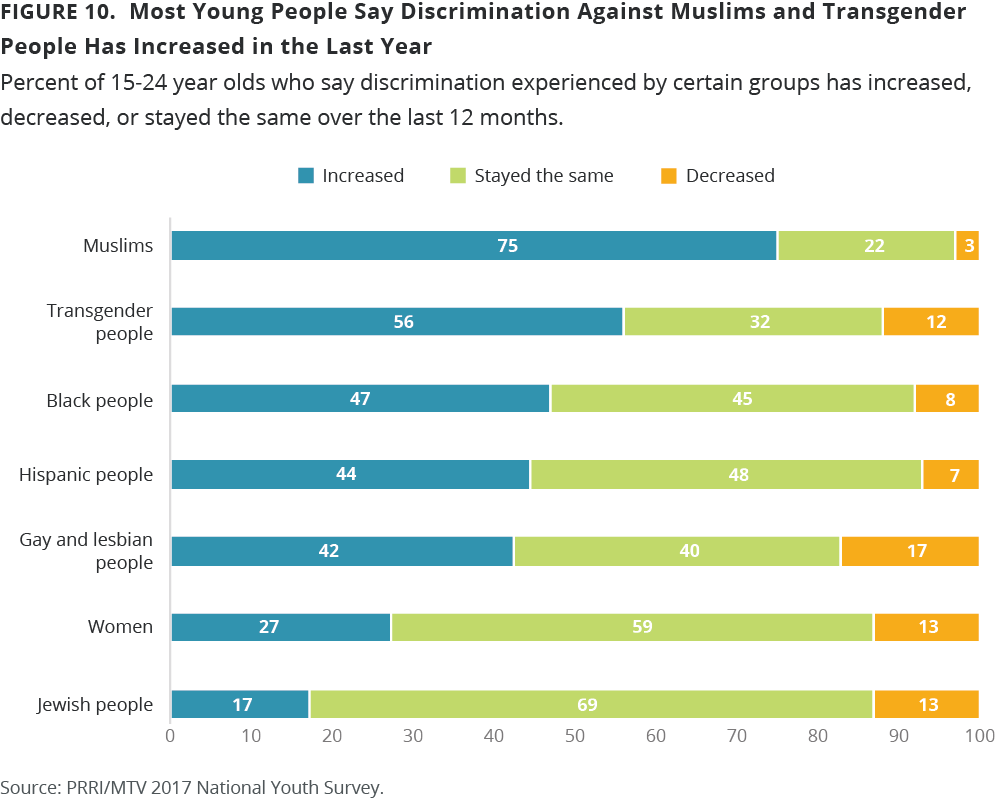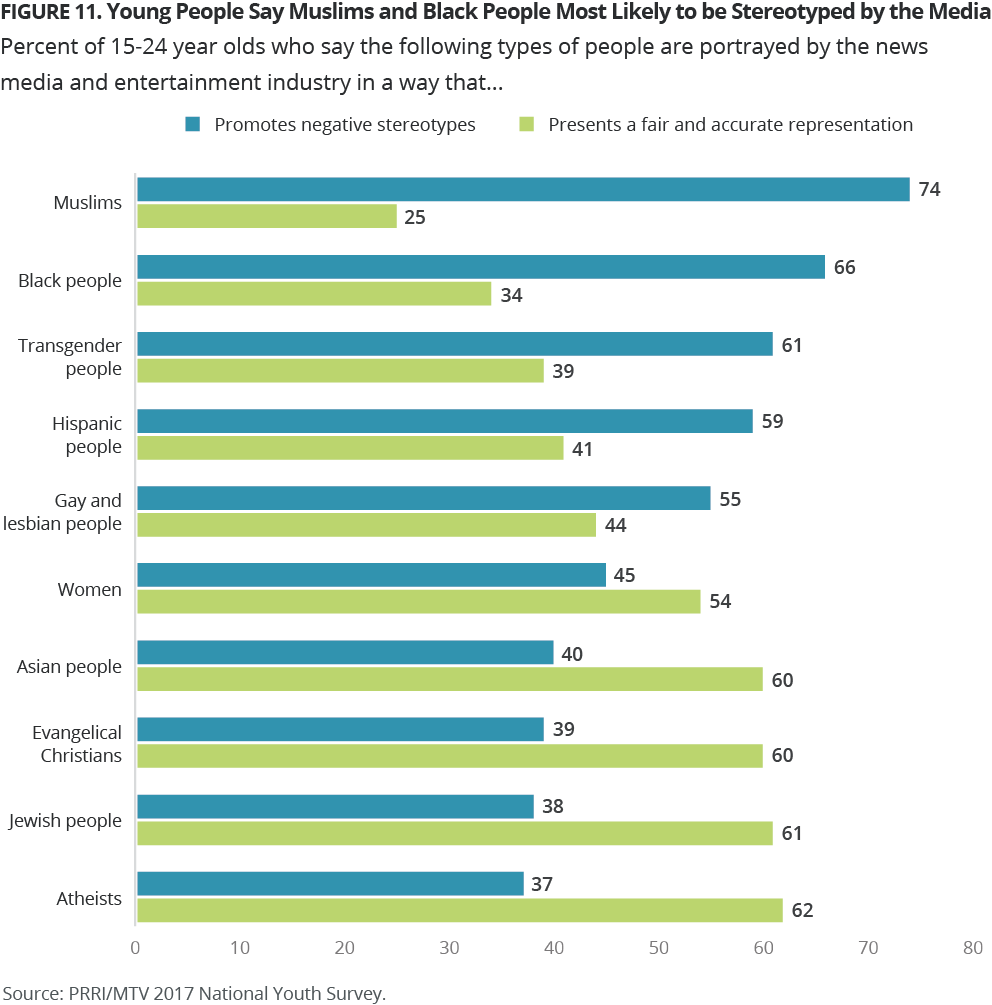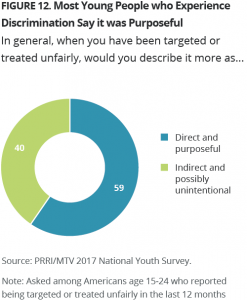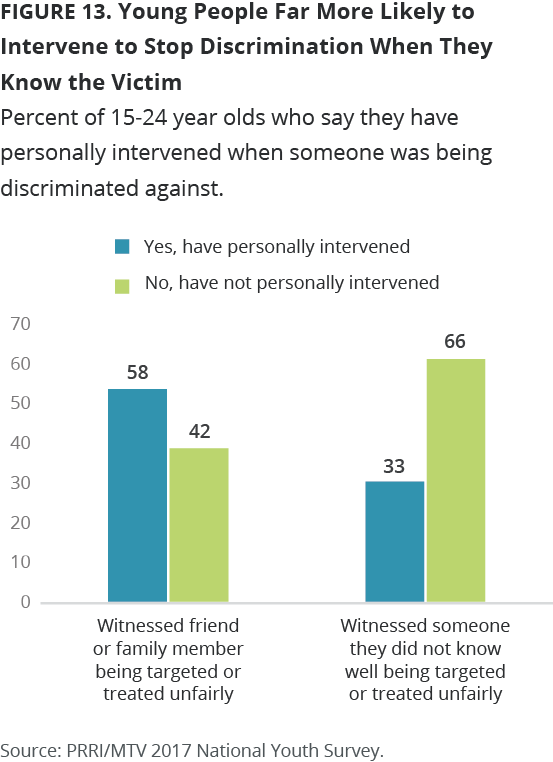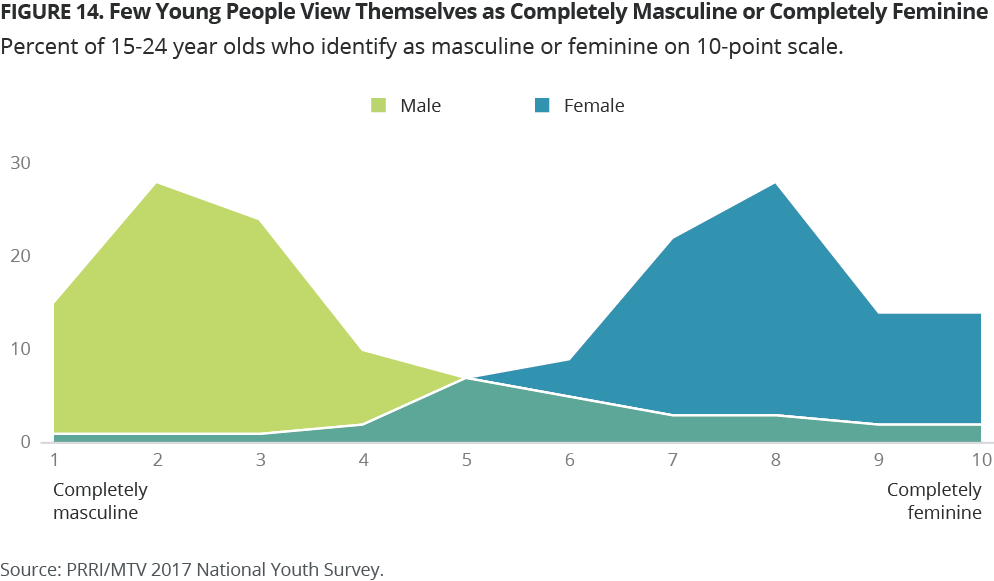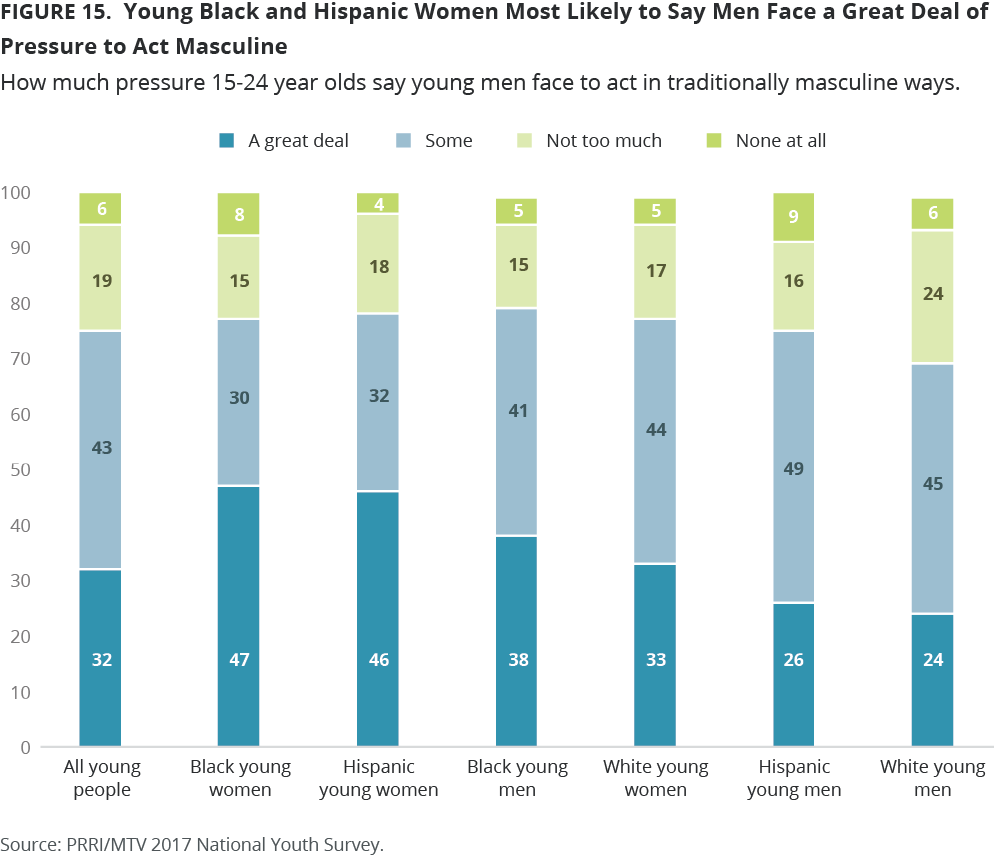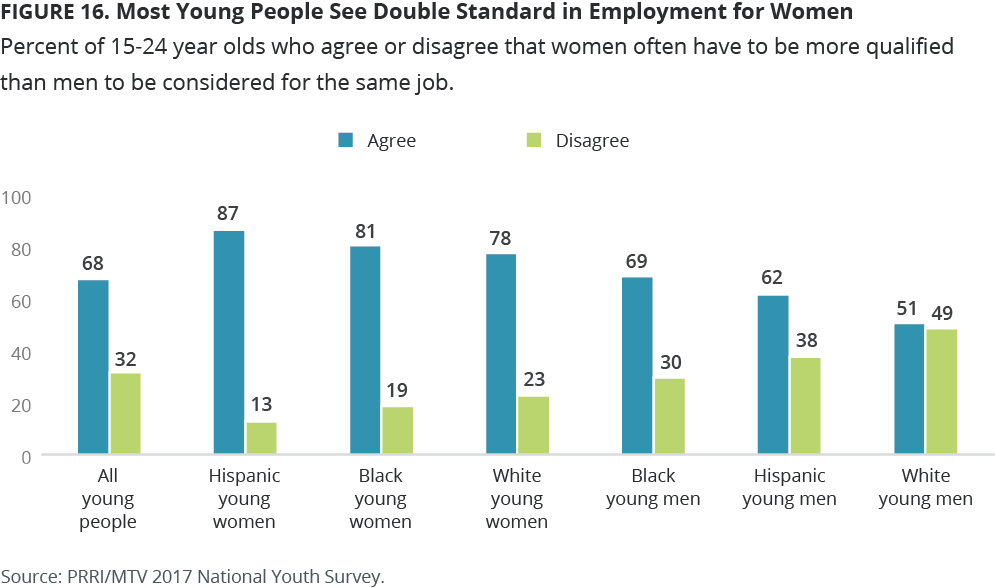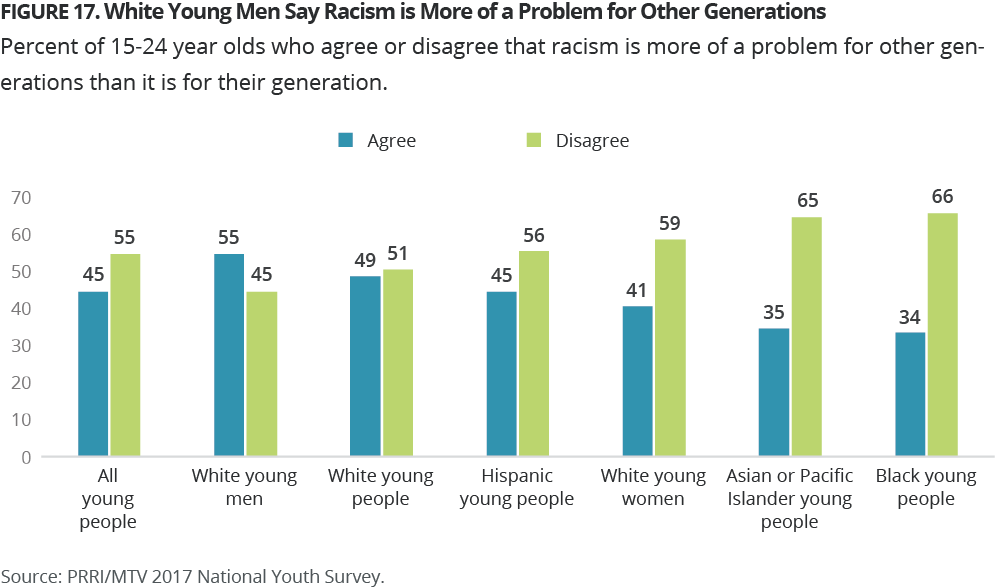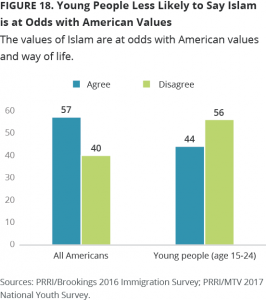Diversity, Division, Discrimination: The State of Young America | MTV/PRRI Report
Executive Summary
I. Perceptions of Discrimination, Personal Experience with Bias, and Concerns about Safety
Experiences with bias and discrimination are relatively common among young people age 15-24.
One in four (25%) young people report having been targeted or treated unfairly themselves in the last 12 months because of their race or ethnicity, gender, sexual orientation or gender identity, immigration status, or religious beliefs.
• Asians and Pacific Islanders (35%), black (30%), and to a lesser extent Hispanic young people (24%) are more likely than white young people (4%) to have experienced racially-motivated discrimination in the last 12 months.
• Nearly one-third (32%) of young people who identify as LGBT report that they personally have been mistreated or targeted because of their sexual orientation or gender identity.
• A majority (54%) of young women report witnessing or personally experiencing incidents of gender bias, while young men (34%) are far less likely to report the same. One in five (20%) young women say they have personally experienced discrimination because of their gender.
There is widespread agreement among young people that Muslims face substantial discrimination in the U.S.
Eighty-four percent of young people say Muslims face a lot of discrimination in the U.S. today, including more than eight in ten black (88%), API (88%), Hispanic (88%), and white young people (81%).
• Young people also believe transgender and gay and lesbian people face a lot of discrimination in the U.S. More than seven in ten young people say transgender people (79%) and gay and lesbian people (72%) are experiencing a lot of discrimination.
• More than seven in ten (72%) young people also perceive a lot of discrimination against black people.
Most young people believe that discrimination against Muslims and transgender people is on the rise.
A majority of young people believe that discrimination against Muslims (75%) and transgender people (56%) has increased in the past 12 months; about half (47%) say black people are facing increasing discrimination.
• Three-quarters (75%) of black young people believe that discrimination against black people has risen in the past 12 months, and 59% of Hispanic young people say that Hispanic people are facing increasing discrimination.
Most young people who experience discrimination believe it is purposeful, and more than four in ten report fearing for their personal safety.
Among young people who have been targeted or mistreated for any part of their identities, nearly six in ten (59%) say it was direct and purposeful, rather than indirect and possibly unintentional. More than four in ten (43%) say this treatment caused them to fear for their personal safety.
• Young women who have been targeted are significantly more likely than young men who have been targeted to say they feared for their personal safety (49% vs. 32%, respectively).
About half of young people who have witnessed bias say they have intervened, and are more likely to do so if they know the victim.
Nearly half (49%) of young people who have witnessed someone being discriminated against say they have personally intervened.
• Young people are about twice as likely to intervene when the victim is someone they know well, such as a friend or family member, rather than someone they do not know well (58% vs. 33%, respectively).
Young people report having more conversations about discrimination and bias in the last 12 months.
A majority (55%) of young people report having more conversations with friends or family members about groups of people being targeted or treated unfairly in the last 12 months. More than six in ten Hispanic (62%) and black young people (61%) and about half of white (51%) and API young people (50%) report this.
• However, there is a considerable gender divide among white young people. White young women are much more likely than white young men to report having more conversations in the last 12 months about discrimination (61% vs. 42%, respectively).
II. Views of Protests and Social and Political Engagement
Young people express more negative than positive views about recent protests and marches, although close to half of young women overall view them favorably.
A majority of young people describe recent protests and marches negatively, as “pointless” (16%), “counterproductive” (16%), “divisive” (12%), or “violent” (11%). Only about one-third ascribe positive value to them, saying they are “inspiring” (16%), “powerful (16%)”, or “effective” (4%).
• Young women express more positive views of recent protests and demonstrations than young men (44% vs. 27%, respectively).
Young women are more socially and politically active than young men.
More than four in ten young people have engaged in the following activities in the last 12 months: Liking or following a campaign or organization online whose cause you support (44%), signing an online petition (43%), or posting on social media about an issue (43%). Fewer young people report volunteering for a group or cause they care about (34%), donating money to a campaign or cause (22%), contacting an elected official (19%), or attending a public rally or demonstration (19%).
• Young women are more politically and socially engaged than young men. Nearly half (48%) of young women say they have signed an online petition, compared to 39% of young men. Young women are also much more likely to have volunteered for a group or cause they care about (37% vs. 30%, respectively), or even donated money to a campaign or cause (25% vs. 18%, respectively).
• However, young women are also more likely to say that insufficient information and fear of criticism inhibits their involvement. A majority (55%) of young women say not knowing enough about the issues is a reason they would not get involved in particular campaigns or causes, compared to 41% of young men. Young women are nearly twice as likely to say avoiding criticism is a reason to abstain from getting involved (29% vs. 16%, respectively).
III. Young People’s Politics and Priorities: Divided by Race, Ethnicity, and Gender
Young people support free speech on campus, even if its content is offensive.
Nearly two-thirds (64%) of young people—including 71% of young college graduates—say colleges and universities should allow speakers on campus who promote views about race, gender, or religion that are offensive to some students. About one-third (35%) disagree.
• At the same time, young people are divided on the relative importance of avoiding speech that is offensive or hurtful versus talking frankly about sensitive topics. Nearly half (49%) of young people agree that even if certain people are offended, it is important to speak frankly about sensitive issues and problems. A slim majority (51%) say it is more important to avoid using language that is hurtful or offensive.
Young people’s perspectives on race relations and LGBT rights vary widely by race, ethnicity, and gender.
Eight in ten (80%) black young people and a majority of API (55%) and Hispanic (52%) young people say race relations are a critical issue to them personally, while only 37% of white young people agree. Nearly half (46%) of white young women say race relations are a critical concern to them personally, compared to only 29% of white young men.
• Black young people are more likely than other young people to believe Americans are divided over race. Nearly three-quarters (73%) of black young people say Americans are very divided over race, compared to 51% of API young people and fewer than half of Hispanic (45%) and white young people (43%).
• Young women are about twice as likely as men to prioritize the issue of LGBT rights: 36% of young women say it is a critical issue, compared to 19% of young men. Young women are also about twice as likely as young men to say gender equality is a critical matter (51% vs. 26%, respectively).
Young people as a whole feel more positively about Obama than Trump, but the politics of young people are deeply divided along racial lines.
Seventy percent of young people view former president Barack Obama favorably, while 28% have an unfavorable opinion of him. In sharp contrast, only 25% of young people view Donald Trump positively, while 72% have an unfavorable view of him.
• Obama is very popular among young people of color—especially black young people, of whom 96% view him favorably. White young people, particularly young white men, express much less positive views of Obama. Only 53% of white young men view Obama favorably, while close to half (45%) have an unfavorable opinion of him.
• White young people (35%) hold more favorable views of Trump than Hispanic (17%), API (6%), and black young people (5%). However, young white people are less favorably inclined towards Trump than white Americans overall; 46% of white Americans view Trump favorably.
More than 1 in 3 white young people believe “reverse” discrimination is a serious problem.
About one-third (36%) of white young people say discrimination against white people is as serious as that experienced by minority groups. Only 16% of black, 19% of API, and 28% of Hispanic young people agree.
• White young men are more likely than white young women (43% vs. 29%, respectively) to say discrimination against whites is as serious a problem as discrimination against other groups.
• A majority (55%) of white Americans overall—including roughly equal numbers of white men (55%) and white women (53%)—agree that discrimination against white people has become as big a problem as discrimination against black people and other minority groups.
Nearly one-third of young people, and almost half of white young men, say efforts to increase diversity harm white people.
About one-third (32%) of young people, including 38% of white young people, believe efforts to increase diversity almost always come at the expense of whites.
• White young men are more divided. Nearly half (48%) believe diversity efforts will harm white people, while more than half (52%) disagree. Only 28% of young white women believe efforts that promote diversity harm white people.
Young men and women have starkly different views on gender discrimination.
More than six in ten (63%) young women believe that women face a lot of discrimination in the U.S., while only 43% of young men say the same. A majority (56%) of young men, including nearly two-thirds (65%) of white young men, say that women do not confront a substantial amount of discrimination in the U.S. today.
IV. Masculine and Feminine Identity and the Pressure to Conform
Fewer than one in five young men and women describe themselves as “completely masculine” or “completely feminine.”
Most young men and women describe themselves as being at least somewhat masculine and feminine. Only 15% of young men and 14% of young women describe themselves as completely masculine or feminine, respectively. One-quarter (25%) of young men and 40% of young women identify themselves as mixed in terms of their masculine and feminine orientation.
Young women are much more likely than men to feel constrained by gender stereotypes.
Young women are more than twice as likely as young men to say they feel stereotypes prevent them from pursuing the things they want to do (38% vs. 17%, respectively).
• Nearly half (47%) of LGBT young people say they feel they cannot do what they want because of stereotypes about their gender.
Most young people believe young men face pressure to act in traditionally masculine ways.
Three in four (75%) young people believe that there is at least some pressure for men to act in traditionally masculine ways.
• Young people overall are somewhat divided over the extent to which social pressure can lead to negative outcomes. Half (50%) of all young people say societal pressure to conform to conventional notions of masculinity limits the type of friendships men can have with other men. Close to half (46%) of young people say it encourages sexually aggressive behavior while just as many (46%) say that it encourages homophobic attitudes. Forty-three percent of young people say that pressure to act masculine encourages violent behavior in general.
• There are substantial divisions between young men and women about the affects that this pressure has on young men. Young women are far more likely than young men to say this pressure encourages sexually aggressive behavior (54% v. 37%, respectively), encourages violent behavior in general (53% vs. 34%, respectively), and encourages homophobic attitudes (54% vs. 39%, respectively).
I. The Current Political and Cultural Outlook
Overall, young people (age 15-24) have a positive outlook on the country’s future. Nearly six in ten (59%) say America’s best days lie ahead, while only 41% say the country’s best days are behind us.1 Young people are somewhat more optimistic than Americans as a whole. Slightly more than half (52%) of all Americans say that the country’s best days are ahead.2
Feelings of optimism are evident across various racial and ethnic groups, with some significant variation. Nearly two-thirds (66%) of Asian and Pacific Islander (API) young people, six in ten (60%) white, non-Hispanic, young people, and a majority of Hispanic (56%) and black, non-Hispanic, young people (54%) say America’s best days are ahead of us.3 Notably, fewer than four in ten (39%) black people overall express this sense of optimism. A majority (57%) of all black Americans say America’s best days are behind us.4
There are modest differences between young men and women. More than six in ten (62%) young men say the country’s best days are yet to come, while 55% of young women agree.
Critical Issues
Three issues are cited most often by young people as being critically important to them: Roughly six in ten young people say jobs and unemployment (60%), terrorism (60%), and the cost of higher education (57%) are critical issues to them. About half of young Americans say climate change (51%), the growing gap between the rich and the poor (49%), and race relations (47%) are critical matters. Only about four in ten young people say that issues of immigration (42%) and gender equality (38%) are critically important. About one-third (34%) of young people say discrimination against Muslims is a critical issue, while only 28% say LGBT rights are critically important.
Young people of different racial and ethnic backgrounds express substantially divergent priorities. Eight in ten (80%) black young people say race relations are a critical issue, compared to only 37% of white young people. A majority of API (55%) and Hispanic young people (52%) say race relations are a critical concern. White young people are also less likely to prioritize the issue of immigration. Roughly half of Hispanic (52%), black (49%), and API young people (47%) say immigration is critically important to them, while only 35% of white young people say the same. A majority (54%) of black young people say discrimination against Muslims is a critical issue, compared to 41% of Hispanic, 35% of API, and 26% of white young people.
The priorities of young men and young women differ sharply. Young women are about twice as likely as men to prioritize the issue of LGBT rights: 36% of young women say it is a critical issue, compared to 19% of young men. Young women are also about twice as likely to say gender equality is a critical matter (51% vs. 26%, respectively).
Among white young people, women are far more likely to say race relations are a priority for them. Nearly half (46%) of white young women say race relations are a critical concern, compared to only 29% of white young men. White young women are also more likely than their male counterparts to say the growing gap between the rich and the poor (45% vs. 37%, respectively) and discrimination against Muslims (33% vs. 20%, respectively) are critical issues.
Views of Political Parties and Leaders
Although most young people between the ages of 15 and 24 were too young to vote for Barack Obama, he remains very popular among this age cohort. Seventy percent of young people view the former president favorably, while 28% have an unfavorable opinion of him. In sharp contrast, only 25% of young people view Donald Trump positively, while 72% have a negative view of him. Young people express less positive feeling about Trump than Americans overall do, 38% of whom hold a favorable view of him.5 Roughly half (48%) of young people say they have a positive impression of Hillary Clinton, and more than six in ten (61%) view Bernie Sanders favorably.
Young people express somewhat more favorable views of Obama, and much less favorable views of Trump, than the public overall. About six in ten (62%) Americans overall have a favorable view of Obama, while under four in ten (38%) Americans have a favorable view of the current president.6
Views of prominent political figures vary significantly by race and ethnicity. An overwhelming number of black (96%) and API young people (89%) have a favorable opinion of Obama, as do roughly three-quarters (76%) of Hispanic young people. About six in ten (59%) white young people also express positive feelings about the former president. Notably, white young men view the former president less favorably than white young women (53% vs. 64%, respectively). Close to half (45%) of white young men view Obama unfavorably.
Trump is viewed negatively among every racial and ethnic group—although white young people are much more likely than their peers to view the current president favorably. Thirty-five percent of white young people—including 43% of white young men—hold a favorable view of Trump, compared to 17% of Hispanic, 6% of API, and 5% of black young people. Negative feelings for Trump are strongest among black young men and women and Hispanic young women. At least seven in ten black young men (70%), black young women (72%), and Hispanic young women (74%) view Trump very unfavorably.7
White Americans overall express significantly more favorable views of Trump than white young people. Nearly half (46%) of white Americans—including 53% of white men and 40% of white women—report having a positive view of Trump.8
A majority of black (79%), API (64%), and Hispanic young people (54%) have a favorable opinion of Hillary Clinton, while only 37% of white young people share this view. Notably, white young men have a significantly more favorable view of Trump than of Clinton (43% vs. 28%, respectively). White young women, conversely, are much more likely to view Clinton favorably than Trump (46% vs. 26%, respectively).
Young people are about twice as likely to have a positive view of the Democratic Party (57%) as they are to have the same view of the Republican Party (31%). Nearly two-thirds (66%) have an unfavorable opinion of the GOP.
White young people view the political parties similarly, but nonwhite young people rate the Democratic Party more positively. Forty-three percent of white young people view the Republican Party favorably, while a similar number (46%) have a favorable view of the Democratic Party. However, nearly two-thirds (64%) of Hispanic young people, more than three-quarters (76%) of API young people, and more than eight in ten (84%) black young people view the Democratic Party favorably.
Again, the views of white young men and women differ considerably. White young men are more likely to have a positive view of the Republican Party than the Democratic Party (49% vs. 40%, respectively). White young women, on the other hand, are much more likely to have a favorable opinion of the Democratic Party than the Republican Party (53% vs. 37%, respectively).
The 2016 Election
Young people who voted in the 2016 presidential election were more than twice as likely to vote for Clinton as they were to vote for Trump. Sixty percent of young people who voted supported Clinton, while 28% report they voted for Trump.9 More than one in ten (12%) say they voted for a third-party candidate. Most (74%) young people who voted for Hillary Clinton report that their parents supported her candidacy, as well.
Views of Protests
In general, young people have mostly negative feelings about the protests, marches, and demonstrations that have been held around the country over the last 12 months.10 A majority of young people describe these gatherings as “pointless” (16%), “counterproductive” (16%), “divisive” (12%), or “violent” (11%). Only about one-third ascribe more positive value to them, saying they are “inspiring” (16%), “powerful” (16%), or “effective” (4%).
However, views are highly stratified by race and ethnicity. About six in ten white young people express negative views of recent protests and marches, describing them as counterproductive (20%), pointless (17%), divisive (13%), or violent (11%). Black young people look more favorably on these events, with nearly half saying they are inspiring (23%), powerful (20%), or effective (6%). API young people are similarly divided, with half saying they are powerful (22%), inspiring (17%), or effective (11%). Fewer Hispanic young people describe recent marches, protests, and demonstrations as inspiring (21%), powerful (19%), or effective (3%).
Young women express more positive views of protests than young men. More than four in ten women view recent protests and demonstrations positively—inspiring (21%), powerful (20%), or effective (3%). Only 27% of young men express similar views. More than six in ten young men say recent protests, marches, and demonstrations were counterproductive (20%), pointless (19%), divisive (13%), or violent (10%).
There are also sharp divisions in views of protests by political affiliation. Young Democrats express much more enthusiasm for recent protests than young Republicans do. A majority of young Democrats describe these events as inspiring (26%), powerful (25%), or effective (6%). Conversely, nearly nine in ten young Republicans see them as pointless (27%), counterproductive (26%), violent (20%), or divisive (14%).
Political Involvement
Although young people do not report a high degree of involvement in political or social causes, many are involved in online activities, such as posting about an issue on social media, signing an online petition, or following a campaign or organization. More than four in ten young people report liking or following a campaign or organization online whose cause they support (44%), having signed an online petition (43%), or posting on social media about an issue that mattered to them (43%) within the last 12 months. Fewer young people report having volunteered for a group or cause they care about (34%), donating money to a campaign or cause (22%), contacting an elected official (19%), or attending a public rally or demonstration (19%).
Young women are demonstrating significantly higher levels of political and social engagement than young men. Nearly half (48%) of young women say they have signed an online petition, compared to 39% of young men. Young women are also more likely to have liked or followed a campaign or group online (50% vs. 39%, respectively), volunteered for a group or cause they care about (37% vs. 30%, respectively), or even donated money to a campaign or cause (25% vs. 18%, respectively).
The gender gap in online social and political activism is generally modest among black young people, but stark among white and Hispanic young people. Forty-four percent of white young women signed an online petition within the last year, compared to 34% of white young men. Nearly six in ten (58%) Hispanic young women report having signed an online petition, while 47% of Hispanic young men say the same. Nearly half (47%) of white young women have posted on social media about a cause that matters to them; only 31% of white young men report similar activity. Close to six in ten (57%) Hispanic young women report posting on social media in the last 12 months, compared to 43% of Hispanic young men. White young women (50% vs. 35%, respectively) and Hispanic young women (58% vs. 44%, respectively) are also far more likely than white and Hispanic young men to report having liked or followed a campaign online.
There is a substantial political divide in the social and political engagement of young people. Young people whose parents supported Clinton in the 2016 presidential election are much more engaged than those whose parents voted for Trump. A majority (52%) of young people whose parents voted for Clinton say they have signed an online petition in the last 12 months, compared to only 33% of those whose parents supported Trump. Young people whose parents supported Clinton are also more likely to have posted on social media about an issue (50% vs. 35%, respectively) or attended a rally or demonstration (27% vs. 11%, respectively).
Reasons for Not Getting Involved
There are a number of reasons young people give for why they choose not to get involved in particular campaigns or causes. The most common reason is that they do not think they are well informed enough. Nearly half (48%) of young people say that not knowing enough about the issues is a reason they do not get involved. About four in ten (38%) say they don’t participate because they do not believe their actions would make a difference. Fewer young people say fear of being criticized (22%) or that there are not any issues they care about (20%) are reasons for abstaining from political involvement.
There is little difference between young men and young women in the degree of apathy expressed. Forty percent of young men say they don’t think their actions will make a difference, compared to 35% of young women. However, young women are far more likely than young men to say that not knowing enough about the issues is a reason they don’t get involved (55% vs. 41%, respectively). Young women are also more concerned about criticism: Twenty-nine percent say avoiding criticism is a reason to abstain, while only 16% of young men say the same.
White young women are unique in the extent to which they say feeling uninformed is an impediment to getting involved in a campaign or cause. Nearly six in ten (58%) white young women believe this, compared to 52% of Hispanic young women, 48% of black young women, and 41% of white young men.
Free Speech on Campus
Nearly two-thirds (64%) of young people—including 71% of college graduates—say colleges and universities should allow speakers on campus who promote views about race, gender, or religion that are offensive to some students. About one-third (35%) disagree and say such people should not be permitted to share their views on campus.
On this issue, black young people are more evenly divided than other young people. Nearly half (49%) of black young people say speakers that would be offensive to some students should not be invited to college campuses, while half (50%) say they should. About two-thirds of white (66%), Hispanic (66%), and API young people (71%) support allowing colleges to host such speakers.
Notably, there are few differences by political ideology. At least six in ten young liberals (61%), moderates (64%), and conservatives (69%) say speakers should be permitted on college campuses whether or not they would offend certain students.
At the same time, young people overall are wary of speech that is hurtful or offensive to some people. Young people are divided over whether it is more important to prioritize a frank discussion of sensitive topics or to avoid using offensive language. Nearly half (49%) of them agree that even if certain people are offended, it is important to speak frankly about sensitive issues and problems facing the country. A slim majority (51%) say it is more important to avoid using language that is hurtful or offensive to some people when discussing sensitive issues.
The general public is less divided on this issue. A majority (57%) says that it is more important to speak frankly about issues and problems in the country, while fewer than four in ten (39%) say that it is more important to avoid language that can be hurtful or offensive.11
Black young people stand out in their belief that it’s more important to avoid hurtful or offensive language. More than six in ten (61%) black young people say it’s more important to avoid language that’s offensive than it is to speak frankly about sensitive issues, a view shared by about half of API (52%), white (50%), and Hispanic young people (46%).
Notably, black young people are much more likely to prioritize sensitivity than black adults overall. Fewer than half (46%) of black Americans overall say that it is more important to avoid offensive language. Among whites overall, there is similarly less concern about the need to avoid potentially hurtful language—only 35% of white Americans believe that sensitivity should be prioritized over speaking frankly.12 The views of all Hispanic Americans are similar to those of Hispanic young people.
Divided America: Race, Religion, Politics, and Class
The issue that young people are most likely to say divides the country is politics. More than three-quarters (77%) of young people say Americans are very divided by politics, a majority (57%) say the public is very divided by wealth and income, and about half (48%) say Americans are very divided by race. Fewer than four in ten (38%) young people say we are very divided by religion.
There is broad agreement among young people that the public is sharply divided by politics, but far less consensus on the issues of race and class. Nearly three-quarters (73%) of black young people say Americans are very divided over race, compared to 51% of API young people and fewer than half of Hispanic (45%) and white young people (43%). Black and Hispanic young people are also much more likely than white young people to perceive class divisions. More than six in ten black (68%) and Hispanic young (63%) people say Americans are very divided by wealth or income, compared to majorities of API (56%) and white young people (51%).
On the question of religious division, young black Protestants are most likely to say the public is divided. A majority (54%) of young black Protestants say the country is very divided by religion, compared to about four in ten white evangelical Protestant (44%), religiously non-Christian (43%), and religiously unaffiliated young people (40%). Fewer than three in ten white mainline Protestant (29%) and Catholic young people (28%) say the country is very divided by religion.
II. Discrimination and Media Stereotypes
Who Faces Discrimination in the U.S.?
Racial Discrimination
Young people tend to believe racial minority groups experience substantial discrimination in the U.S., although the extent to which they perceive discrimination varies. More than seven in ten (72%) young people say there is a lot of discrimination against black people in the U.S. today. Roughly six in ten (63%) believe Hispanic people face a lot of discrimination, but only three in ten (30%) young people say the same of Asian people in the United States today. Relatively few young people (23%) say white people experience a great deal of discrimination, and even fewer (16%) say white men are facing a lot of discrimination.
Perceptions of discrimination vary somewhat among young Americans by racial and ethnic background. While nearly nine in ten black (89%) and API young people (87%) and eight in ten Hispanic young people (80%) say black people face a lot discrimination in the U.S. today, fewer than two-thirds of white young people (64%) agree. But views among young whites vary considerably by gender: only 57% of white young men say black people face a lot of discrimination in the U.S. today, compared to 72% of white young women.
Black Americans overall are as likely as black young people to perceive discrimination, but there are stark generational divisions among whites and Hispanics. Nearly nine in ten (87%) black Americans say black people experience a lot of discrimination, compared to about six in ten (62%) Hispanic Americans and fewer than half (49%) of white Americans overall.13 The gender gap is more modest among whites overall than among young whites: Fewer than half (45%) of white men overall, and a slim majority (53%) of all white women, say black people face a lot of discrimination.
There are similarly notable racial divisions in views on the discrimination experienced by Hispanic people. At least seven in ten black (78%), API (74%), and Hispanic young people (72%) say that Hispanic Americans face a considerable amount of discrimination in the U.S. today, a view shared by 56% of white young people. However, white young men are particularly likely to have doubts about the degree of discrimination faced by Hispanic people. Fewer than half (47%) of white young men say Hispanic people face a lot of discrimination in the U.S.; 52% say they do not.
There is more agreement among young people about whether Asian people face a lot of discrimination in the U.S. today. About three in ten white (27%) and Hispanic young people (31%), as well as 38% of black young people, believe Asian people experience substantial discrimination. API young people are divided, with 49% expressing the belief that Asian Americans experience a lot of discrimination, and roughly as many (50%) saying they do not.
White young people are not any more likely than young people overall to say white Americans face a lot of discrimination in the U.S. today. Only 23% of white young people believe white people contend with a lot of discrimination. Even fewer white young people (18%) say that white men experience a substantial degree of discrimination. But white young women and white young men differ somewhat on this issue. More than one-quarter (26%) of white young men say white men face a great deal of discrimination in the U.S., while only 10% of white young women agree.
Gender and LGBT Discrimination
Young people tend to perceive high rates of discrimination based on sexual orientation and gender identity, but there is less consensus on the issue of gender discrimination. Nearly eight in ten (79%) young people say there is a lot of discrimination against transgender people in the U.S. today, and close to three-quarters (72%) say there is a lot of discrimination against gay and lesbian people in the U.S. today. A slim majority (53%) of young people believe women face a great deal of discrimination, while 47% disagree.
Young people are more likely than Americans overall to perceive discrimination based on sexual orientation and gender identity. Roughly six in ten Americans overall say that transgender people (64%) and gay and lesbian people (61%) face a lot of discrimination.14 Only about half of seniors (age 65 and up) say transgender people (54%) and gay and lesbian people (54%) experience a lot of discrimination in the U.S. today.
On the question of how much discrimination women face, the perceptions of young men and women differ sharply. More than six in ten (63%) young women believe that women face a lot of discrimination in the U.S. today, while only 43% of young men say the same. A majority (56%) of young men say that women do not contend with a substantial amount of discrimination.
Among Americans overall, fewer believe that women face a lot of discrimination, but a sharp gender divide persists. Fewer than half (45%) of Americans overall, including only 37% of men and a majority (54%) of women, say that women face a lot of discrimination in the U.S. today.
White young people are far less likely to believe women face a lot of discrimination than young people of other racial and ethnic backgrounds. More than six in ten Hispanic (62%), API (69%), and black young people (70%) believe women confront a lot of discrimination in the U.S. today, but fewer than half (44%) of white young people agree. Not surprisingly, there are considerable differences in opinion among whites by gender. While a majority (54%) of white young women say that there is a lot of discrimination against women in the U.S. today, only about one-third (35%) of white young men say the same. Nearly two-thirds (65%) of white young men do not believe women today are experiencing a lot of discrimination.
Religious Discrimination
The vast majority of young people agree that Muslims face a lot of discrimination today. More than eight in ten (84%) agree there is a lot of discrimination against Muslims in the United States today, while fewer than one-third of young people say that there is a lot of discrimination against Jews (32%), evangelical Christians (24%), and atheists (18%). About two-thirds (66%) of Americans overall say that there is a lot of discrimination against Muslims.15
There is broad agreement among young people of different racial and ethnic backgrounds over the amount of discrimination experienced by Muslims. More than eight in ten white (81%), black (88%), API (88%), and Hispanic young people (88%) believe Muslims are experiencing a lot of discrimination in the U.S. today.
Majorities of all major religious groups also say Muslims face a great deal of discrimination. Close to nine in ten Hispanic Catholic (91%), religiously unaffiliated (90%), black Protestant (89%), and religiously non-Christian young people (86%) say there is a lot of discrimination against Muslims in the U.S. today. Roughly seven in ten white Catholic (75%) and white evangelical Protestant young people (69%) say the same.
Young white evangelical Protestants are significantly more likely to believe that evangelical Christians face more discrimination than most other racial, ethnic, and religious minority groups. Nearly six in ten (57%) young white evangelical Protestants say evangelical Christians face a lot of discrimination in the U.S. today. Far fewer believe atheists (12%), Asian people (15%), Jewish people (27%), women (31%), Hispanic people (38%), and black people (42%) experience a lot of discrimination. However, a majority agree that gay and lesbian people (55%), transgender people (62%), and Muslims (69%) face a lot of discrimination in the U.S. today.
Has Discrimination Increased?
Over the last 12 months, young people have become generally more likely to say discrimination against minority groups has increased rather than decreased. However, perceptions of discrimination vary depending on the identity of the group in question. Young people are most likely to say discrimination against Muslims has increased over the last 12 months: Three-quarters (75%) hold this view, while about one in five (22%) say the amount of discrimination has stayed the same, and three percent say it has decreased.
A majority (56%) of young people say the amount of discrimination experienced by transgender people in the U.S. has increased in the last year. Nearly one-third (32%) say that the amount of discrimination has remained the same, and roughly one in ten (12%) say it has decreased.
Fewer young people believe that the discrimination experienced by gay and lesbian people in the U.S. has increased in the last 12 months: Only about four in ten (42%) say discrimination against gay and lesbian people is increasing. Four in ten (40%) say it has stayed the same, and only about one in five (17%) say it has decreased.
Fewer than half of young people say the amount of discrimination experienced by black (47%) and Hispanic (44%) people has increased, while roughly equal numbers say it has remained about the same (45% and 48%, respectively). Fewer than one in ten young people say Hispanic people (7%) and black people (8%) are facing less discrimination today. However, three-quarters (75%) of black young people believe there is more discrimination against black people today, while 59% of Hispanic young people say discrimination against Hispanics has risen over the last year.
Relatively few young people believe women are facing increased levels of discrimination. Only about one-quarter (27%) say there has been a rise in gender discrimination over the past year. Nearly six in ten (59%) say that, over the last 12 months, the amount of discrimination experienced by women has stayed the same. Thirteen percent say it has decreased.
Only 17% of young people believe that Jewish people have faced increasing discrimination over the previous year. Nearly seven in ten (69%) say the level of anti-Semitism in the U.S. has stayed about the same, and thirteen percent say it has decreased.
The Demographic Divide on Discrimination
There is a stark racial divide in perceptions of discrimination against black and Hispanic people. A majority (56%) of Hispanic young people, six in ten (61%) API young people, and three-quarters (75%) of black young people believe black Americans are experiencing a greater degree of discrimination today. In contrast, only 35% of white young people believe this is the case. However, there is a substantial gender divide among white young people. Nearly half (46%) of white young women, but only about one-quarter (26%) of white young men, say that black people are facing increased amounts of discrimination. Similarly, a majority of black (51%), Hispanic (59%), and API young people (59%) say Hispanic people are facing more discrimination, while only 36% of white young people agree.
LGBT young people are more likely to say discrimination against gay, lesbian, and transgender people has increased than non-LGBT young people. Three-quarters (75%) of LGBT young people say discrimination against transgender people has increased over the last 12 months, compared to 54% of non-LGBT young people. Similarly, while nearly six in ten (58%) LGBT young people say gay and lesbian people are experiencing more discrimination today than they were a year ago, only about four in ten (41%) non-LGBT young people agree.
There is a modest gender gap in perceptions of discrimination based on gender and sexual orientation. About one-third (32%) of young women, compared to 22% of young men, say discrimination against women has increased over the past 12 months. However, young women are substantially more likely than young men to say that gay and lesbian people (49% vs. 36%, respectively) and transgender people (64% vs. 48%, respectively) are experiencing more discrimination today than in the previous year.
Media Stereotypes
Media Portrayals of Racial and Ethnic Groups
Young people are divided in their opinions about the ways in which racial minorities are portrayed in news and entertainment media. Nearly two-thirds (66%) of young people say black people are portrayed by the news media and entertainment industry in a way that promotes negative stereotypes, while about one-third (34%) say the media presents a fair and accurate representation. About six in ten (59%) young people say Hispanic people are portrayed negatively in the media, while about four in ten (41%) say their characterizations are fair and accurate. Young people are more likely to say Asian people are portrayed accurately: Six in ten (60%) say the media presents a fair and accurate representation of Asian people.
There is general agreement among young people that black and Hispanic people are portrayed negatively in the news and entertainment media. At least six in ten white (60%), Hispanic (68%), black (78%), and API young people (84%) believe the media portrays black Americans in ways that promote negative stereotypes. And a majority of young whites (54%) and at least six in ten Hispanic (62%), black (66%), and API young people (76%) say that Hispanic people are negatively portrayed in the media. Notably, there is a significant gender divide among white young people: 70% of white young women say black people are portrayed negatively, compared to only about half (52%) of white young men. Nearly half (47%) of white young men say the media presents a fair and accurate representation of black people.
There is a greater divergence of opinion in views of how Asian people are treated in the media. Roughly four in ten white (38%), black (38%), and Hispanic young people (40%) say that Asian people are negatively stereotyped in the media, while an overwhelming majority (71%) of API young people agree.
Media Portrayals of Women and LGBT People
Most young people believe the media depicts gay, lesbian, and transgender people in ways that promote stereotypes, but fewer say the same of how women are portrayed. More than six in ten (61%) say the news and entertainment media promote negative stereotypes of transgender people, and a majority (55%) say the same of gay and lesbian people. However, fewer than half (45%) of young people say that women are depicted negatively in the news and entertainment media. Most (54%) young people believe women are portrayed in ways that are accurate and fair.
Young people who identify as LGBT are much more likely to say the media’s depiction of gay, lesbian, and transgender people encourages stereotyping. More than seven in ten (72%) LGBT young people believe the news and entertainment industry negatively portray gay and lesbian people, and more than eight in ten (83%) believe transgender people are portrayed negatively. A significantly smaller majority of non-LGBT young people believe gay and lesbian people (54%) and transgender people (58%) are depicted negatively in the media.
Young women and men are of very different minds when it comes to impressions of how women are portrayed by the media. A majority (53%) of young women say media portrayals of women encourage negative stereotypes, while fewer than four in ten (38%) young men agree. More than six in ten (62%) young men say the media provides a fair and accurate representation of women.
Media Portrayals of Religious Groups
There is widespread agreement among young people that Muslims are generally depicted negatively by the media. Nearly three-quarters (74%) of young people say the news and entertainment media portray Muslims negatively. In contrast, fewer than four in ten young people say evangelical Christians (39%), Jewish people (38%), and atheists (37%) are depicted in ways that promote negative stereotypes.
There is near consensus of opinion across religious groups on how Muslims are depicted in the media. A majority of young people across religious groups believe Muslims are depicted negatively, including a majority of white evangelical Protestant (57%), white mainline Protestant (72%), Catholic (73%), black Protestant (76%), religiously non-Christian (81%) and religiously unaffiliated young people (82%).
With the exception of those who belong to non-Christian religious groups, relatively few young people across religious traditions believe Jewish people are portrayed negatively in the media. Fewer than four in ten Catholic (30%), white mainline Protestant (32%) and white evangelical Protestant young people (37%) say Jewish people are negatively portrayed in the media and entertainment industry. About four in ten black Protestant (42%) and unaffiliated young people (41%) say Jewish people are depicted in ways that encourage stereotypes, while half (50%) of young people who belong to non-Christian religious groups say the same.
There is greater agreement among young people about how atheists are treated in the media. About one-third of white evangelical Protestant (29%), Catholic (34%), white mainline Protestant (36%), and religiously non-Christian young people (36%) say the depiction of atheists in the media promotes stereotypes. Roughly four in ten black Protestant (38%) and unaffiliated young people (43%)—including 53% of self-identified atheists—agree.
For the most part, young people of different religious backgrounds do not believe evangelical Christians are portrayed negatively in the media. Fewer than four in ten unaffiliated (32%), Catholic (34%), black Protestant (36%), white mainline Protestant (39%), and religiously non-Christian young people (39%) say evangelical Christians are subject to negative depictions in the news and entertainment media. However, two-thirds (67%) of white evangelical Protestant young people say that evangelical Christians are portrayed negatively.
III. Personal Experiences with Bias
Most young people report having witnessed episodes of personal discrimination within the last year. Seven in ten (70%) young people report they have personally experienced or witnessed someone being targeted or treated unfairly in the last 12 months because of their race or ethnicity, gender, sexual orientation or gender identity, immigration status, or religious beliefs. More than four in ten (43%) young people say their friends or family members have been targeted or treated unfairly in the last 12 months. One in four (25%) young people report having been targeted or treated unfairly themselves.
Most young people who report having been targeted or mistreated say it was purposeful and a significant minority say they feared for their safety. Nearly six in ten (59%) young people who experienced discrimination say it was direct and purpose rather than indirect and possibly unintentional. Forty-three percent say they feared for their personal safety.
Racial Discrimination
Racial discrimination is the most common type of bias young people report having witnessed or experienced in the last 12 months. Nearly six in ten (57%) young people say they saw someone targeted or treated unfairly because of their race or ethnicity or experienced it themselves. However, only 14% say they have experienced racial discrimination personally.
The extent to which racial discrimination is experienced first- or second-hand is affected significantly by racial and ethnic background. Fewer than half (45%) of white young people report having seen someone targeted due to their race or ethnicity or experiencing it themselves. In contrast, more than eight in ten (81%) black young people and more than seven in ten API (75%) and Hispanic young people (71%) say they have seen someone experience racial discrimination or personally experienced racial discrimination.
Nonwhite young people are also far more likely to report having been personally targeted or mistreated themselves because of their racial or ethnic background. Roughly one-third of API (35%) and black young people (30%) and about one-quarter (24%) of Hispanic young people say they have personally experienced racially-motivated discrimination in the last 12 months. Only four percent of white young people report having been a target of racial discrimination.
Most young people who have experienced racial discrimination believe it was purposeful, while a significant minority say they felt afraid for their safety. Among young people who have reported being a victim of racial discrimination, nearly half (46%) say they feared for their personal safety when they were targeted or mistreated. Two-thirds (67%) of young people say that their experience of being targeted or mistreated based on their race or ethnicity was direct and purposeful, rather than indirect and possibly unintentional.
Discrimination Based on Sexual Orientation and Gender Identity
Close to half (46%) of young people say they have seen someone targeted or mistreated because of their gender identity or sexual orientation or have been targeted themselves in the last 12 months. Only about one in five (19%) say they have seen a friend or family member experience this type of discrimination. Only five percent say they themselves have been targeted or mistreated based on their sexual orientation or gender identity.
Young women are far more likely than young men to report having seen someone experience discrimination or having experienced it themselves because of their gender identity or sexual orientation. A majority (57%) of young women say this, compared to only 36% of young men. This discrepancy may be at least partly explained by the fact that young women are more likely to know someone who is LGBT: More than eight in ten (82%) young women have a close friend or family member who is LGBT, compared to 66% of young men.
Young people who identify as LGBT are far more likely than those who do not to have witnessed someone being mistreated because of their gender identity or sexual orientation or to have personally experienced this. More than eight in ten (83%) LGBT young people report having seen or experienced this, compared to only 42% of those who do not identify as LGBT.
Nearly one-third (32%) of young people who identify as LGBT report that they themselves have personally been mistreated or targeted because of their sexual orientation or gender identity. A majority (56%) of LGBT young people who experienced discrimination for their sexual orientation or gender identity say they feared for their safety, and roughly as many (54%) believe the acts were direct and purposeful.
Gender Discrimination
More than four in ten (44%) young people report having witnessed someone being targeted or treated unfairly because of their gender or having the experience themselves in the last year. Significantly fewer (12%) young people report having been personally targeted or mistreated due to their gender.
Young women are far more likely to say they have seen incidents of gender discrimination than young men. A majority (54%) of young women report personally experiencing or witnessing someone else being targeted as a result of their gender, compared to about one-third (34%) of young men. Notably, only 26% of white young men say they have seen someone being targeted or treated unfairly because of their gender or have experienced it themselves.
Fewer young people report witnessing or experiencing gender discrimination than racial discrimination. One in five (20%) young women say they personally have experienced gender-based discrimination in the last 12 months. Notably, there are no substantial differences between the experiences of white young women and young women of color. White, black, and Hispanic young women are about equally likely to report being targeted or mistreated (19% vs. 17% vs. 25%, respectively).
Close to half (48%) of women who say they have personally experienced discrimination because of their gender say they have feared for their safety, and roughly as many (49%) say the incident was direct and purposeful rather than incidental or unintentional.
In general, young women who report being targeted for any part of their identity are significantly more likely than young men who report the same to have feared for their personal safety (49% vs. 32%, respectively).
Religious Discrimination
More than four in ten (44%) young people report they have personally experienced or witnessed someone being targeted or treated unfairly because of their religious identity. Only eight percent of young people say they personally have experienced religious discrimination in the past 12 months.
The likelihood of witnessing or experiencing religiously based discrimination varies considerably by religious tradition. Less than three in ten (29%) young white mainline Protestants and 37% of young Catholics say they have witnessed or experienced incidents of religious discrimination in the past 12 months. In contrast, roughly half of religiously unaffiliated young people (47%), young white evangelical Protestants (48%), young black Protestants (51%), and young members of non-Christian religious traditions (52%) say they have witnessed someone being targeted or mistreated because of their religion or faced this themselves.
No group of young people is more likely to report personally experiencing religious discrimination than members of non-Christian religious traditions. Sixteen percent of religiously non-Christian young people say they have been targeted or treated unfairly because of their religion in the last 12 months, compared to fewer than one in ten black Protestant (9%), unaffiliated (8%), white evangelical Protestant (8%), and Catholic young people (5%).
Young people who have personally experienced religious discrimination are less likely than those who have experienced some other types of discrimination to say they felt fearful for their safety, but most believed such incidents were purposeful. Only 42% of young people who have been targeted because of their religion say they were worried about their personal safety, but nearly two-thirds (64%) said the acts were purposeful rather than unintentional.
Immigrant Discrimination
No type of discrimination is less commonly reported by young people than that based on immigration status. Fewer than four in ten (38%) young people say they have experienced or witnessed someone being targeted or mistreated because of their immigration status in the last 12 months, and only three percent report having personally experienced it.
Experiences among young people vary considerably by racial and ethnic background. Six in ten (60%) Hispanic young people and about half of black (50%) and API young people (48%) say they have experienced or seen someone being mistreated in the past 12 months due to their immigration status. In contrast, only about one-quarter (26%) of white young people report a similar experience.
Direct experience with discrimination based on immigration status is not widely reported among any racial or ethnic group. Nine percent of Hispanic young people say they personally have been targeted or treated unfairly because of their immigration status in the last twelve months.
Intervention
Despite the prevalence of discrimination, most young people say they have not personally intervened to stop acts of discrimination. Six in ten (60%) young people say they have not personally intervened to help someone who was being discriminated against, while 39% report they have done this. Among young people who report having witnessed someone being mistreated or targeted because of their race or ethnicity, gender, sexual orientation or gender identity, immigration status, or religious beliefs, about half (49%) say they have personally intervened.
Willingness to intervene in such situations is somewhat variable among young people by race. More than four in ten black (44%) and Hispanic young people (44%) report having intervened to help someone who was experiencing discrimination. In contrast, fewer than four in ten API (39%) and white young people (36%) say they have intervened. However, the difference in rates of intervention is largely attributable to a lack of white young people’s having witnessed discrimination.16 Among young people who do report having witnessed such discrimination, roughly equal numbers of white (48%), black (50%), and Hispanic young people (53%) say they have intervened.
One of the most important factors determining whether or not young people intervene in instances of discrimination is whether they have a close connection to the person being targeted. Nearly six in ten (58%) young people who report having witnessed a friend or family member being targeted or mistreated in the last year say they have intervened. In contrast, only one-third (33%) of those who report seeing someone they didn’t know well being targeted say they intervened to stop it.
Difficult Conversations: Talking about Bias
Although young people may not intervene regularly when witnessing acts of discrimination, the issue has become a more frequent topic of conversation. A majority (55%) of young people report having more conversations with friends or family members about groups of people being targeted or treated unfairly in the last 12 months. Only about one in five (22%) young people say they are talking about this issue with the same frequency, while eight percent say they are talking about it less. Fifteen percent say the issue doesn’t really come up at all.
The increasing frequency with which young people are talking about the issue of discrimination with friends or family varies somewhat by racial and ethnic background. More than six in ten Hispanic (62%) and black young people (61%) say the issue of discrimination has come up more often in conversations with friends and family members. About half of white (51%) and API young people (50%) say the same. However, there is a considerable gender divide among white young people. White young women are much more likely than white young men to report having more conversations about discrimination (61% vs. 42%, respectively).
Young people are divided over the difficulty of having open and honest conversations about race with people of a different racial or ethnic background. Nearly half say such conversations are very (12%) or somewhat (36%) difficult, while a slim majority say it is not too (36%) or not at all (16%) difficult.
White young people are somewhat more likely to say having conversations about race is not that difficult. A majority (54%) of white young people—including 56% of white young men—say having an open and honest dialogue about race with someone of a different racial background is not that difficult, a view shared by fewer than half of black (47%) and Hispanic young people (47%). Notably, nearly two-thirds (66%) of API young people say it is not that difficult to talk about the issue of race with people who have a different racial or ethnic background.
Despite some disagreement about the difficulty of discussing the issue of race, most (60%) young people agree that “people are too sensitive when it comes to race.” About four in ten (39%) young people disagree.
The idea that people are too sensitive about race is most strongly felt among white young people. Nearly two-thirds (64%) of white young people say people are too sensitive about the issue. Six in ten (60%) Hispanic young people also agree. Black young people are divided: Forty-six percent say people are more sensitive about the issue of race than is necessary, while 54% disagree. API young people are even more closely divided, as 51% agree and 48% disagree.
However, this sentiment is much more common among white young men than white young women. Nearly three-quarters (74%) of white young men agree that people are too sensitive about race, a view held by only 53% of white young women. Nearly half (47%) of white young women do not believe there is too much sensitivity around the issue of race.
Young people are also not of one mind about the difficulty of having open and honest conversations about religious issues with those who do not share their religious beliefs. Close to half (46%) say it is at least somewhat difficult to have these conversations, while a majority (54%) say it is not that difficult. Young white mainline Protestants and young white Catholics are least likely to believe talking about religion is difficult. Fewer than four in ten young white Catholics (36%) and young white mainline Protestants (39%) say it is difficult to discuss religion with those who do not share their religious beliefs. About half of young members of non-Christian religious traditions (45%), black Protestants (49%), unaffiliated people (50%), white evangelical Protestants (50%), and Hispanic Catholics (50%) say such conversations are at least somewhat difficult.
IV. Gender Stereotypes, Gender Identity, and Sexual Orientation
One in ten (10%) young people identify as lesbian, gay, bisexual, or transgender (LGBT).17 Among Americans overall, just four percent identify as LGBT.18
Young women are far more likely than men to identify as LGBT (14% vs. 6%, respectively). This is primarily due to the fact that more young women identify as bisexual than young men—11% of young women identify as bisexual, compared to only 4% of young men.
Masculinity and Femininity
When asked to rate their relative masculinity and femininity, few young men rate themselves as “completely masculine,” and few young women identify as “completely feminine.”19 Instead, many young men and women locate themselves on a spectrum of masculinity and femininity. Two-thirds (67%) of young men describe themselves as mostly or completely masculine, although only 15% identify themselves as completely masculine. One-quarter (25%) identify themselves as being more mixed in terms of masculinity and femininity. Only seven percent describe themselves as mostly or completely feminine. Young women rate themselves similarly, although they are somewhat less likely to say they are mostly or completely feminine. A majority (56%) of young women describe themselves as mostly or completely feminine, but only 14% identify as completely feminine. Four in ten (40%) identify as mixed in terms of masculinity and femininity. Only three percent of young women identify themselves as being mostly or completely masculine.
On the question of femininity and masculinity, black young people are distinct in the degree to which they identify as definitively masculine or feminine. Nearly one-third (32%) of black young men say they are completely masculine, while nearly as many (29%) black young women say they are completely feminine. In contrast, only 15% of Hispanic young men, 12% of white young men, and six percent of API young men say they are completely masculine. The pattern is similar among women, with relatively few Hispanic (13%), white (12%), and API young women (four percent) describing themselves as completely feminine.
Gender Stereotypes
Most young people do not feel that gender stereotypes limit their freedom to pursue activities. Roughly three in ten (28%) young people agree with this statement, while more than seven in ten (72%) disagree.
Young women are much more likely than young men to feel constrained by gender stereotypes. Nearly four in ten (38%) young women, but only 17% of young men, say they feel stereotypes about their gender prevent them from pursuing the things they want to do. Similar numbers of black (40%), Hispanic (39%), and white young women (36%) feel constrained by gender stereotypes. There are modest differences among young men by racial and ethnic background. Nearly one-quarter (23%) of black young men and 18% of Hispanic young men feel confined by gender stereotypes, compared to 14% of white young men.
Notably, young people who feel they have masculine and feminine qualities in roughly equal proportion are more likely to feel constrained by gender stereotypes. About one-third (36%) young people who describe themselves as being about equally masculine and feminine say gender stereotypes prevent them from pursuing what they want to do.
Nearly half (47%) of LGBT young people say they feel they cannot do what they want because of stereotypes about their gender.
Most young people also do not worry about being judged or criticized for not acting feminine or masculine enough. Nearly two-thirds (63%) of young Americans say this isn’t something they worry about, while 37% say they do have fears about not acting appropriately masculine or feminine.
Young women are only slightly more likely than young men to report worrying about being judged for not being feminine or masculine enough (39% vs. 34%, respectively).
There are few differences in the experiences of young men by racial or ethnic background. More than three in ten white (31%), black (37%) and Hispanic young men (40%) say they sometimes worry about being judged or criticized for not acting masculine enough. However, there are sharp racial and ethnic divisions among women. While only about one-quarter (26%) of black young women say they worry about being criticized or judged for not being feminine enough, 37% of white young women and nearly half (46%) of Hispanic young women express these fears.
Again, young people who identify as about equally masculine and feminine are more likely (53%) to express fears about being judged and criticized.
Young people who identify as LGBT are highly likely to express fears about these types of criticisms. More than six in ten (63%) LGBT young people say they worry about being judged or criticized if they do not act masculine or feminine enough.
The Power of Traditional Masculinity
Most young Americans believe young men experience at least some pressure to conform to traditional notions of masculinity. Three-quarters of young people say young men face a great deal (32%) or some (43%) pressure to act in traditionally masculine ways. Approximately one-quarter say there is not too much pressure (19%) or none at all (6%).
Although most young men (72%) and young women (78%) acknowledge that young men face at least some pressure to abide by traditionally masculine standards of behavior, women are more likely to believe men are experiencing intense pressure. Only about one-quarter (26%) of young men say there is a great deal of pressure to conform to traditional ideas of masculine behavior, while nearly four in ten (39%) women say the same.
White young people are significantly less likely than nonwhite young people to believe young men face societal pressure to behave in traditionally masculine ways. Fewer than one-third (28%) of white young people say young men face a great deal of pressure, compared to 36% of Hispanic, 37% of API, and 43% of black young people. Black and Hispanic young women are particularly likely to perceive this type of pressure: Nearly half of black young women (47%) and Hispanic young women (46%) say young men experience a great deal of pressure to conform to traditional norms concerning masculinity.
There are modest regional differences. More than one-third of young people in the South (36%) and West (35%) say young men come under a great deal of pressure to act masculine, compared to 29% of those in the Northeast and about one-quarter (26%) of young people in the Midwest.20
Young people overall are somewhat divided over the extent to which social pressure can lead to negative outcomes. Half (50%) of all young people say societal pressure to conform to conventional notions of masculinity limits the type of friendships men can have with other men. An identical number (50%) say that this leads men to treat women as weaker and less capable. Close to half (46%) of young people say it encourages sexually aggressive behavior while just as many (46%) say that it encourages homophobic attitudes. Forty-three percent of young people say that pressure to act masculine encourages violent behavior in general. There is greater agreement among young people that pressure to act masculine prevents men from expressing their emotions in healthy ways—60% agree that it does.
There are substantial divisions between young men and women about the affects that this pressure has on young men. A majority (52%) of young men and nearly seven in ten (69%) young women say that societal pressure to act masculine prevents young men from expressing their emotion in healthy ways. Young women are also more likely than young men to say this pressure limits the type of friendships men can have with other men (56% vs. 44%, respectively). About six in ten (58%) young women say pressure to act masculine leads men to treat women as weaker and less capable, while only 41% of young men agree. Young women are also far more likely than young men to say this pressure encourages sexually aggressive behavior (54% v. 37%, respectively), encourages violent behavior in general (53% vs. 34%, respectively), and encourages homophobic attitudes (54% vs. 39%, respectively).
Identifying as a Feminist
Nearly four in ten (39%) young people say they consider themselves to be feminist. Six in ten (60%) say they do not. Willingness to adopt this label varies significantly among young people, by race, ethnicity, gender, education, and region.
Young women are about twice as likely as young men to identify as feminist (52% vs. 27%, respectively). Nearly three-quarters (73%) of young men say they do not describe themselves as feminist.
Feminist young men are far less likely to identify as masculine than those who reject the label. Only half (50%) of feminist young men identify as mostly or completely masculine, while nearly three-quarters (73%) of young men who are not feminist identify as mostly or completely masculine.
White and black young people are notable in their eschewing of the feminist label. Slightly more than one-third of black (34%) and white young people (37%) identify as feminist. In contrast, close to half (45%) of Hispanic young people and more than six in ten (62%) API young people consider themselves to be feminist.
There are notable regional differences as well. Nearly half (46%) of young people in the Western U.S. identify as feminist, compared to about four in ten (41%) of those in the Northeast, and fewer than four in ten in the South (37%) and Midwest (34%).
Young people with more formal education are also more willing to identify as feminist. A majority (54%) of college-educated young people identify as feminist, compared to only 36% of those with some high school education.
Gender and Discrimination
Most young people perceive a double standard for women in seeking employment. More than two-thirds (68%) of young Americans agree women often have to be more qualified than men to be considered for the same job; approximately one-third (32%) disagree. The attitudes of young people are consistent with the public as a whole: Two-thirds (67%) of Americans say that to be considered for the same job, women must be more qualified than men, while approximately one-third (32%) disagree.21
This view is held by the vast majority of young women, while young men are somewhat more divided. More than eight in ten (81%) young women agree women are held to a higher standard when seeking employment, while only 55% of young men agree. More than four in ten (44%) young men disagree. Notably, white young men (51%) are significantly less likely to believe women face a double standard during the job search than Hispanic young men (62%) and black young men (69%).
Few young people believe discrimination against men now rivals that experienced by women. More than three-quarters (76%) of young people disagree with the statement, “discrimination against men has become as big a problem as discrimination against women.” Fewer than one in four (24%) agree. Overwhelming majorities of both young men (70%) and young women (82%) reject the idea that men now face the same degree of discrimination as women.
Most young people also roundly reject the notion that women use gender as an excuse. Nearly two-thirds (65%) of young people disagree that “women use their gender as an excuse more than they should.” However, more than one-third (34%) of young people agree with this statement.
There are notable divisions in opinion among young men and women. Young men are far more likely than young women to believe women use gender as an excuse (42% vs. 26%, respectively).
Young Americans with a college degree are less likely to believe women use gender as an excuse than those with less formal education. One-quarter (25%) of young college graduates say women use gender as an excuse, compared to nearly four in ten (37%) young people with a high school education or less who say the same. Notably, nearly half (46%) of young men without a high school degree believe women use their gender as an excuse.
There is greater agreement among young people that the progress made by women has not come at the expense of men. More than eight in ten (82%) young people, including 78% of young men and 86% of young women, do not believe the advancement of women has come at the expense of men.
V. Racial Discrimination and Cultural Anxiety
Racial Prejudice: Progress and Backlash
Is Racism More of a Problem for Past Generations?
Young people are somewhat divided over whether they believe racism is more of a problem for “other generations” than it is for their own generation. Close to half (45%) of young people agree that “racism is more of a problem for other generations than it is for my generation,” while a majority (55%) disagree.
There are racial differences among young people over this question. Close to half of white (49%) and Hispanic young people (45%) say racism is less of a problem for people in their generation, while only about one-third of black (34%) and API young people (35%) agree.
Among both white and Hispanic young people, there are considerable differences in the views of men and women. A majority of white (55%) and Hispanic young men (54%) believe that racism is less of a problem for people their age, while fewer than half of white (41%) and Hispanic young women (35%) agree. Roughly six in ten (59%) white young women and nearly two-thirds (64%) of Hispanic young women believe racism is not any less of an issue for this generation.
“Black people have gotten less than they deserve.”
Young people also tend to agree that black Americans have received less than they deserve. A majority (55%) agree that over the past few years, black people have gotten less than they deserve, while 44% disagree. Young people are substantially more likely to hold this view than the public as a whole; only four in ten (40%) Americans say that black people have gotten less than they deserve over the past few years, while nearly six in ten (58%) disagree.22
Racial divisions over this question are stark among young people. More than eight in ten (85%) black young people, two-thirds (67%) of API young people, and 58% of Hispanic young people agree that black people have gotten less than they deserve. Fewer than half (46%) of white young people say the same.
There is a considerable divergence of opinion in the views of white young men and women. While fewer than four in ten (38%) white young men agree that black people have gotten less than they deserve in recent years, a majority (54%) of white young women express this view. More than six in ten (62%) white young men do not believe black people have gotten less than they deserve over the past few years.
“Reverse” Discrimination
Most young people do not believe that discrimination against white people is on par with that faced by other minorities. Fewer than one-third (31%) believe discrimination against whites has become as big of a problem as discrimination against blacks and other minorities; nearly seven in ten (69%) disagree. Young people are significantly less likely than the general population to hold this view; nearly half (47%) of Americans overall agree that discrimination against whites has become as big a problem as discrimination against minorities.23
White young people are somewhat more likely than other young people to say “reverse” discrimination is a significant problem, although most reject the statement. More than one-third (36%) of white young people say discrimination against white people is akin to that experienced by minority groups, compared to fewer Hispanic (28%), API (19%), and black young people (16%). More than four in ten (43%) white young men, compared to 29% of white young women, believe discrimination against whites is as serious a problem as discrimination faced by black people and other minorities.24
White Americans overall are more likely to affirm this belief than white young people. A majority (55%) of white Americans—including roughly equal numbers of white men (55%) and white women (53%)—agree that “reverse” discrimination is as big an issue as other types of racial and ethnic discrimination.
The politics of young people’s parents also appears closely associated with views about “reverse” discrimination. A majority (55%) of young people whose parents voted for Trump agree that discrimination against whites is as serious a problem as discrimination against black people and other minorities, while only 19% of those whose parents voted for Clinton agree.25
Diversity Efforts’ Impact on Whites?
As the country continues to debate policies encouraging diversity in schools and the workplace, including affirmative action, young people tend to say that those efforts are not detrimental to whites. About one-third (32%) of young people agree that “efforts to increase diversity almost always come at the expense of whites,” while nearly two-thirds (66%) disagree with that statement. The attitudes of young people mirror Americans overall. Approximately one-third (34%) of Americans agree that diversity efforts almost always come at the expense of whites, while about six in ten (61%) disagree.
There are differing perspectives about the impact of diversity efforts among young people. Fewer than four in ten (38%) white young people agree that efforts to increase diversity almost always come at the expense of whites, while more than six in ten (62%) disagree. Significantly fewer black (28%), Hispanic (25%), and API young people (17%) believe efforts to increase diversity are zero-sum and come at the expense of whites.
White young men are about evenly divided on the question of whether diversity efforts will harm white people: Forty-eight percent believe it would; 52% disagree. In contrast, few white young women agree with the statement. Only 28% of white young women believe efforts that promote diversity will harm white people, while more than seven in ten (72%) say increasing diversity will not come at a cost to whites.
Cultural Concerns
Attitudes toward Non-English-Speaking Immigrants
Overall, young people express little concern about coming into contact with immigrants who speak little to no English, especially compared to the wider adult public. Only about one-third (31%) of young people say that it bothers them when they come into contact with immigrants who speak little or no English. Seventy percent of young people say this does not concern them. Among all Americans, four in ten (40%) report they are bothered when interacting with non-English-speaking immigrants.26
A majority of young people overall, regardless of racial or ethnic background, are not bothered by immigrants who do not speak English, but white young people are more likely than others to say that they are bothered. More than one-third (36%) of white young people feel this way, compared to about three in ten (28%) black young people, and fewer than one in five Hispanic (19%) and API young people (16%). In contrast, close to half (45%) of white Americans overall are bothered by immigrants who speak little or no English.
Islam and American Values
Most young people reject the idea that the values of Islam are at odds with American values and the American way of life. A majority (56%) say they are not at odds with American values and way of life, while 44% say that they are. The views of young people diverge from those of the general population, as close to six in ten (57%) Americans say that the values of Islam are at odds with American values. Four in ten (40%) Americans disagree.28
Majorities of every racial and ethnic group of young Americans do not believe Islam is at odds with American culture. Perceptions of Islam among white young people are markedly similar to those expressed by black and Hispanic young people. A little less than half of white (45%) and black young people (45%) say the values of Islam run counter to American values, and roughly four in ten (41%) Hispanic young people agree. Thirty-six percent of API young people agree with the statement. Among the general public, more than six in ten (61%) white Americans and more than half (51%) of Hispanics say that the values of Islam are in conflict with the values of the United States. Fewer than half (45%) of black Americans agree.29
Among religious groups of young people, white evangelical Protestants are the most likely to see the values of Islam as contrary to American values. Nearly seven in ten (69%) white evangelical Protestant young people agree that the values of Islam are at odds with American values and the American way of life. Fewer than half of black Protestant (46%), white mainline Protestant (45%), white Catholic (44%), and Hispanic Catholic young people (42%) say the same. Unaffiliated young Americans are the least likely to see the values of Islam as at odds with American values. Only about three in ten (31%) agree that the values of Islam are at odds with American values and way of life.
Young people whose parents voted for Trump are nearly twice as likely as those whose parents supported Clinton to believe the values of Islam are at odds with American values (60% vs. 34%, respectively).
The U.S.-Mexico Border Wall
Young people are strongly opposed to building a wall along the U.S. border with Mexico. Nearly three-quarters (72%) of young people oppose this policy, including nearly half (49%) who strongly oppose it. Fewer than three in ten (28%) express support for building a wall on the U.S.-Mexico border. While the public as a whole is also unsupportive of this policy, they demonstrate less opposition than young people. Nearly six in ten (58%) oppose the construction of a border wall with Mexico, while 41% support this proposal.30
Opinions on building a wall along the U.S.-Mexico border vary somewhat by race, but a majority of all racial and ethnic groups oppose its construction. Close to two-thirds (64%) of white young people and overwhelming majorities of Hispanic (80%), black (87%), and API young people (92%) oppose the construction of a wall along the border. About one-third (35%) of white young people support this policy. White young men are somewhat more likely than young women to favor building a wall (43% vs. 29%, respectively).
Notably, opposition to building a U.S. border wall with Mexico is constant across regions. Roughly two-thirds of young people in the Midwest (65%) and Northeast (69%), and about three-quarters of those living in the South (74%) and West (76%) oppose the construction of a border wall.
Older white Americans express greater support for this policy, although there is some disagreement between men and women. Nearly half (47%) of white Americans overall support building a wall, including 52% of white men and 43% of white women.31
Travel Ban
Young people also express objections to the temporary so-called “Muslim ban.” More than six in ten (63%) young people oppose temporarily banning people from some majority Muslim countries from entering the U.S., while more than one-third (37%) support this idea.
The issue reveals stark racial and ethnic divisions among young people. White young people (45%) are more than twice as likely as their black (20%) and API peers (15%) to support temporarily banning people from some majority Muslim countries from entering the U.S. Fewer than three in ten (29%) Hispanic young people say the same. A slim majority (51%) of white young men favor temporarily preventing people from majority Muslim countries from entering the U.S., a view that is shared by substantially fewer (37%) white young women.
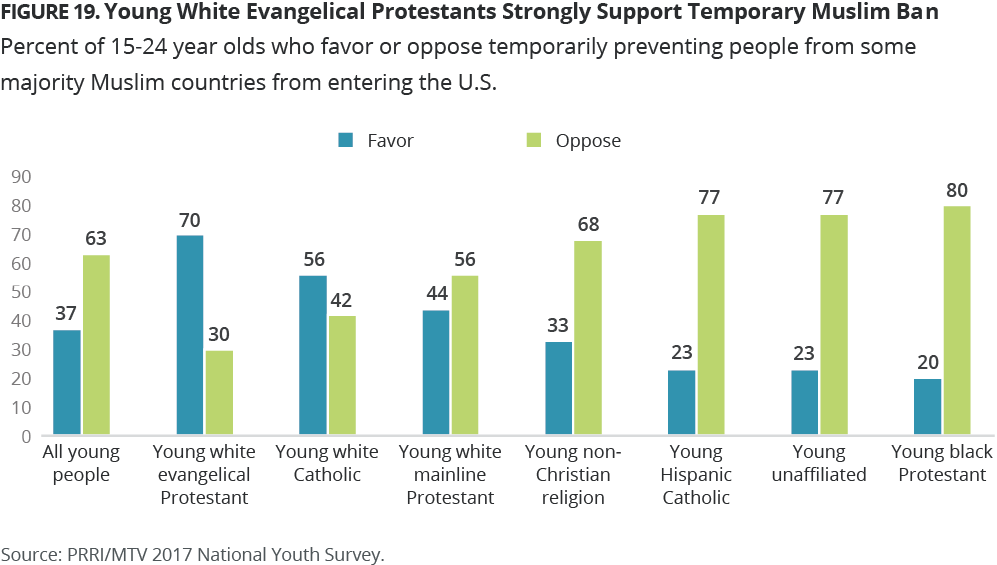
No group of young people is more supportive of banning people from Muslim countries from entering the U.S. than young white evangelical Protestants. Seven in ten (70%) white evangelical Protestant young people favor temporarily banning people from some majority Muslim countries from entering the U.S., as do a majority (56%) of young white Catholics. Fewer than half (44%) of young white mainline Protestants express support for the travel restriction. In contrast, only one-third (33%) of religiously non-Christian young people, and fewer than one-quarter of Hispanic Catholic (23%), religiously unaffiliated (23%), and black Protestant young people (20%) are in favor of restricting travel by people coming from majority Muslim countries.
Appendix: Methodology
This project is the result of a collaboration between PRRI and MTV. The report is based on a large national survey of young people (age 15-24) and a series of eight focus groups conducted among black, white, and Hispanic young people. Focus groups among black young people were conducted in Cincinnati, Ohio on March 8-9, 2017. Focus groups among Hispanic young people were conducted in Charlotte, North Carolina on March 15-16, 2017. Additionally, four focus groups were conducted among white participants, two at each location. At the Charlotte location, white participants included those from rural areas who had conservative political leanings. At the Cincinnati location, white participants were from suburban or urban areas and had moderate or liberal political leanings. Groups were recruited to include roughly equal numbers of male and female participants and segregated by age. All focus groups were conducted at L&E Research facilities.
The survey was designed and conducted by PRRI among a random sample of 2,023 young people age 15-24 who are part of GfK’s YouthPulse panel. Interviews were conducted online in both English and Spanish between July 19 and August 3, 2017.
The initial sample drawn from the YouthPulse panel was adjusted using pre-stratification weights so that it approximates the overall population (15-24-year-olds) in the U.S. as defined by the latest Current Population Survey (CPS). Next, a probability proportional to size (PPS) sampling scheme was used to select a representative sample. Once assigned to the survey, panel participants received an email notification reminder on days four, seven, and twelve of the field period.
The YouthPulse panel is a nationally representative probability sample of teens and young adults age 15 to 24 years old. Panelists are recruited by randomly selecting residential addresses using a process called address-based sampling (ABS). Participants under the age of 18 were included in the panel following the receipt of parental consent. Unlike opt-in panels, households are not permitted to “self-select” into the panel, and are generally limited to how many surveys they can take within a given time period. Additional details about the YouthPulse panel can be found on the GfK website: http://www.gfk.com/en-us/products-a-z/us/gfk-youthpulse-panel/.
To reduce the effects of any non-response bias, a post-stratification adjustment was applied based on demographic distributions from the most recent CPS. The post-stratification weight rebalanced the sample based on the following benchmarks: age, race and ethnicity, gender, census division, metro area, education, and income.
The sample weighting was accomplished using an iterative proportional fitting (IPF) process that simultaneously balances the distributions of all variables. Weights were trimmed to prevent individual interviews from having too much influence on the final results. The use of these weights in statistical analysis ensures that the demographic characteristics of the sample closely approximate the demographic characteristics of the target populations.
The margin of error for the overall survey is +/- 2.7 percentage points at the 95% level of confidence. The design effect for the survey is 1.6. For a full list of sample sizes for racial and ethnic subgroups, see Table 1. In addition to sampling error, surveys may also be subject to error or bias due to question wording, context, and order effects.
Endnotes
1 Here and throughout the report, “young people” refers those age 15-24.
2 PRRI 2017 Kids’ Wellbeing Survey.
3 Here and throughout the report, “white” refers to non-Hispanic whites, “black” refers to non-Hispanic blacks, and we use the acronym “API” to refer to respondents who self-identify as Asian-Pacific Islander.
4 PRRI 2017 Kids’ Wellbeing Survey.
5 PRRI August 2017 Survey.
6 PRRI January 2017 Survey.
7 The sample size was not large enough to report out estimates of young men and women who are API.
8 PRRI August 2017 Survey.
9 Includes those who were eligible to vote and who report voting in the 2016 election.
10 The survey was conducted before the events in Charlottesville, Virginia.
11 PRRI 2016 American Values Survey.
12 PRRI 2016 American Values Survey.
13 PRRI February 2017 Survey.
14 PRRI February 2017 Survey.
15 PRRI February 2017 Survey.
16 Substantially fewer white young people (59%) report having witnessed discrimination of any kind, compared to black (76%), Hispanic (76%), and API young people (81%).
17 The survey found that two percent of young people identify as “gender non-binary,” meaning that they experience their gender identity and/or gender expression as falling outside the categories of man and woman.
18 Same-sex Couple and LGBT Demographic Data Interactive. (May 2016). Los Angeles, CA: The Williams Institute, UCLA School of Law.
19 The Masculinity-Femininity scale is a 10-point scale that ranges from 1 (“completely masculine”) to 10 (“completely feminine”). Respondents scoring between 1 and 3 identified as completely or mostly masculine. Respondents with scores between 4 and 7 are identified as having a mixed orientation, while those who scored 8 to 10 identified as mostly or completely feminine.
20 Regions are defined by the U.S. Census.
21 PRRI 2016 American Values Survey.
22 PRRI 2015 American Values Survey.
23 PRRI 2016 American Values Survey.
24 PRRI 2016 American Values Survey.
25 PRRI/The Atlantic Post-election White Working Class Survey.
26 PRRI 2017 Kids’ Wellbeing Survey.
27 PRRI 2017 Kids’ Wellbeing Survey.
28 PRRI/Brookings 2016 Immigration Survey.
29 PRRI/Brookings 2016 Immigration Survey.
30 PRRI 2016 American Values Survey.
31 PRRI 2016 American Values Survey.
Recommended Citation
Jones, Robert P., Daniel Cox, Molly Fisch-Friedman and Alex Vandermaas-Peeler. “Diversity, Division, Discrimination: The State of Young America” PRRI/MTV. 2018.


